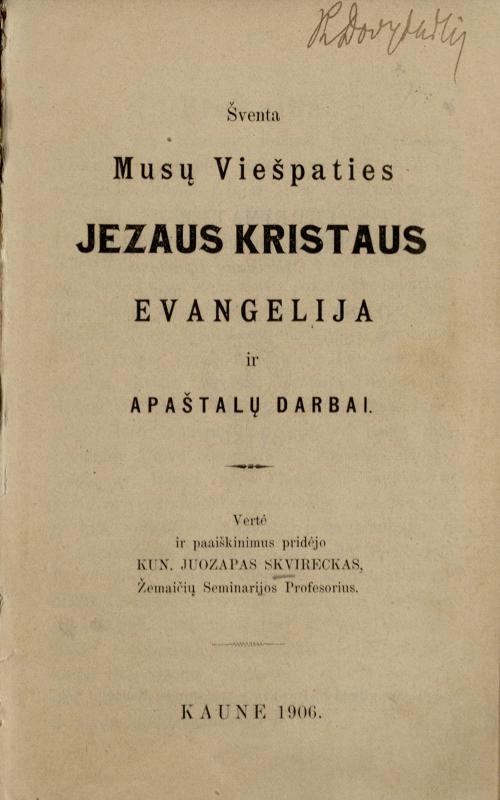Translations of the Bible into Lithuanian
The origins of printing in the Grand Duchy of Lithuania are closely tied to publishing the books of the Bible. In, 1522 Francysk Skaryna established a printing house in Vilnius, where he published books of the Old and the New Testament. The entire Holy Scripture in Polish, one of the spoken languages of the Duchy, was first translated and published in 1563 with the support of Mikalojus Radvila (Mikołaj Radziwiłł) the Black. It was the famous Brest (or Radvila) Bible, translated by at least 18 people.
The first translations of the Bible into Lithuanian were not printed (or their printing was not completed). The Holy Scripture was translated by Jonas Bretkūnas in 1579–1590 from the German translation by Luther, but this translation was not published. In 1657–1660, it was translated from Polish by Samuelis Boguslavas Chylinskis (Samuel Bogusław Chyliński) during his sojourn in England. The printing of this translation was started, but soon discontinued in the absence of support and approval from the Lithuanian Evangelical Reformed community, and the already-printed part of the Old Testament was pulped. The entire New Testament in Lithuanian appeared only in the early 18th century, and the entire Bible was printed in Lithuania Minor soon after.
Nevertheless, Lithuanians discovered texts of the Holy Scripture printed in their native language already in the first Lithuanian-language printed book, “The Catechism” by Martynas Mažvydas, which contained a few psalms. Individual books of the Bible or their parts could be found in many Christian Lithuanian-language books: printed hymnals and catechisms contained psalms; postillas included extracts from the New Testament.
The first translations of the entire Holy Scripture into Lithuanian were collective works, each of them was contributed to by several literary men. The first translator to have translated the Holy Scripture in its entirety into Lithuanian by himself was Archbishop Juozapas Jonas Skvireckas. In 1906, “The Holy Gospel of Our Lord Jesus Christ and the Acts of the Apostles” in his translation was published in Kaunas. In 1911-1937, the entire Holy Scripture was printed in separate volumes.
epaveldas.lt
“The Catechism” by Martynas Mažvydas contains two first texts of the Holy Scripture in Lithuanian – the psalms intended for singing (with score): Psalm 102, “Benedic anima mea domino” (“Liaiupsink duscha mana pana”, “Bless the Lord, O my soul”) and Psalm 50, “Miserere mei Deus secundum magnam” (“Susimilk ant musu Diewe”, “Have mercy on me, O God”).
LMAVB RSS LK-16/1
A printed collection of postillas by the Evangelical Reformed pastor Jonas Bretkūnas contains excerpts from the New Testament.
epaveldas.lt
Jakub Wujek‘s postilla translated from Polish by Mikalojus Daukša contains the first Catholic translation of the New Testament.
The title page exhibited here is not original. As the original one had been lost, a former owner of the book drew its accurate copy himself.
A collection of excerpts from the Gospels and the Acts of Apostles for Sunday and holiday reading, in Lithuanian, compiled by the Evangelical pastor Baltramiejus Vilentas and republished by Lazarus Sengstock.
The hymnal in an Evangelical Reformed prayer book, “Knyga nobažnystės krikščioniškos” (“A Book of Christian Piety”), contained Lithuanian psalm texts and translations of excerpts from the Gospels for Sunday and holiday reading.
epaveldas.lt
Collection of sermons “Punktai sakymų” by the Jesuit Konstantinas Sirvydas contain excerpts from the texts of the Gospels for Sunday and holiday reading as well as compendium of sermons and their translations into Polish. This book is important not only because of the translations of the New Testament into Lithuanian it contains, but also because it is the first original Lithuanian text translated into a foreign language.
LMAVB RSS LK-19/422
Owing to their popularity, the Sunday and holiday readings from the Gospels compiled by the Jesuit Jonas Jaknavičius were reprinted over 40 times. It is thought that this collection of texts for preachers was printed in 1637 (the oldest extant edition dates to 1647). In the 19th century, this book was more than once reprinted by the Vilnius Basilian printing house.
The first complete edition of the New Testament in Lithuanian. The New Testament was first translated into Lithuanian in its entirety by the Evangelical Reformed pastor Samuel Bythner (circa 1632–1673).
The second edition of the entire Bible in Lithuanian. The Holy Scripture in its entirety was first published in Königsberg in 1735. This book was edited by the Evangelical Lutheran pastor, Adam Friedrich Schimmelpfennig (1699–1718), who translated part of the 1735 Bible.
Each composite book intended for everyday pious practice of the Evangelicals would have a hymnal in part composed by psalms from the Old Testament. It would also contain a book of Sunday readings from the Gospels.
It could be guessed from the format of a book which religious denomination it was intended for. Books of Evangelical Lutherans were likely to be high and narrow. The format of this psalm book reminds of that characteristic for Catholic hymnals (kantyczkas), which also contained psalm texts.
Ziwatas pona musu Jezusa Christusa ir Szwęciausias Marios Pannos pagal Ewangelios szwętos trumpay aprasitas ...: su trumpays prykłodays giesmemis ... ir ziwatay szwętuiui … powazniu autoriu iszrinktays. Wilnius: drukarnie kunigu Bazilijonu, 1779.
LMAVB RSS LK-18/42
It was attempted to educate the Catholics about the lives of Jesus Christ, the Virgin Mary, and Saints by publishing collections of consistently recounted lives. The account of the life of Jesus Christ in this book contains retellings of Gospel texts and thus familiarizes the reader with their stories.
LMAVB RSS LK-18/7
This is a translation into Samogitian of the life of Christ written by the great theologian St. Bonaventure in accordance with the Gospels. The translation was printed in the Suprasl Basilian printing house.
Gospel readings for Sundays and holidays in Lithuanian language printed in Russian script (grazhdanka).
This Biblical picture book is written for children. It is a collection of the most important stories of the Holy Scripture retold and illustrated to interest young readers.
The apocryphal Gospel of Nicodemus, a secret follower of Jesus, was translated into Lithuanian and printed in this language in the 19th century.
Apocrypha is the name for those writings by Ancient Jews and Christians that were not included into the biblical canon. Their authorship is often attributed to biblical characters.
The first translation by Archbishop Juozapas Skvireckas, who later translated the entire Holy Scripture, was the New Testament published in 1906.
The entire text of the Holy Scripture in his translation was printed in two languages, Latin and Lithuanian. This work took over 25 years, from 1911 to 1937.

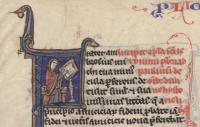
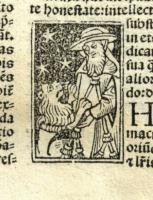
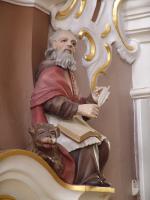
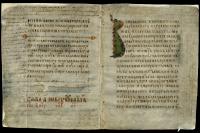
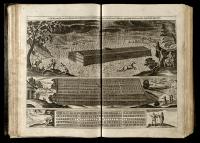
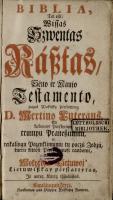
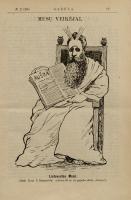
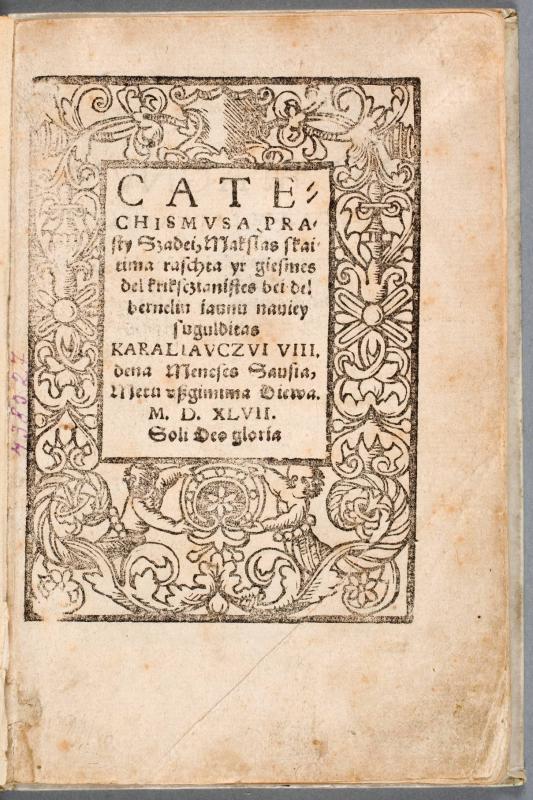
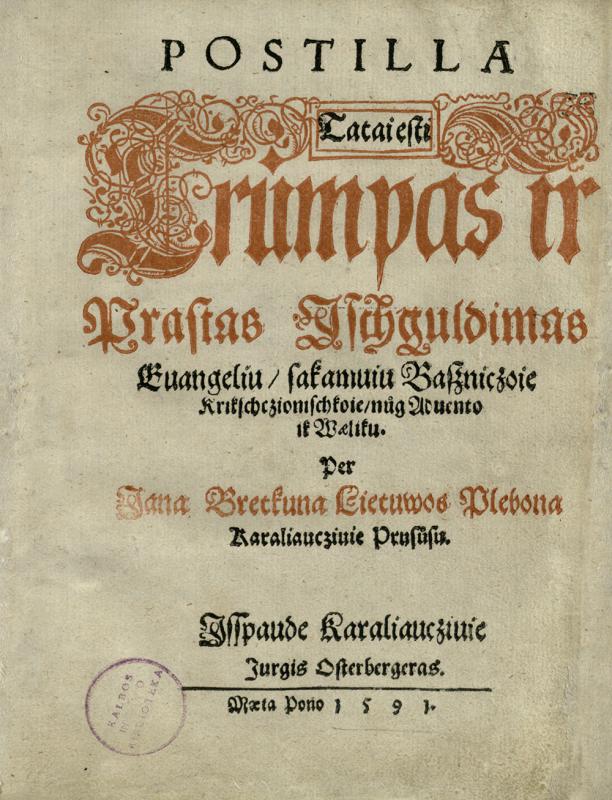
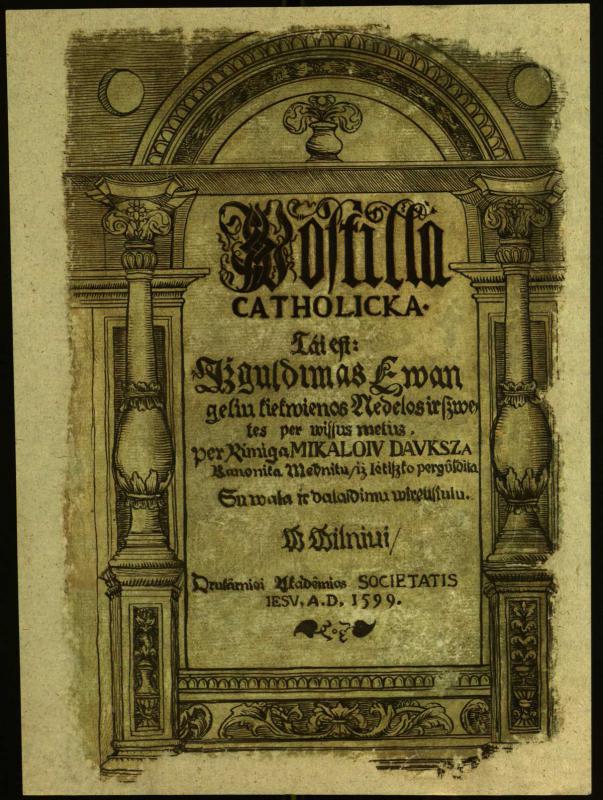
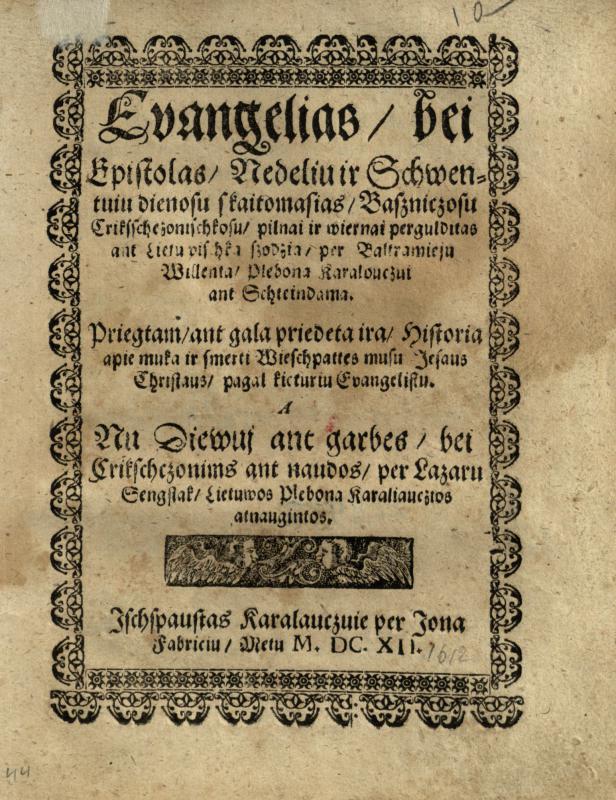
![Kniga nobaznistes krikśćioniszkos ant garbos Diewuy Traycey Sżwentoy wienatijam ant wartojimá báźnićioms dides Kunigistes Lietuwos iszduota. O dabar antra karta perdrukawota, su priedu nekuriu giesmiu Ewangeliu ant pomietkos Szwentuju Dieva, teypag su priedu nekuriu małdu. [Karaliaučius: L. K. Radvilaitės lėšomis: Reussnerio spaustuvė, 1684]. Kniga nobaznistes krikśćioniszkos ant garbos Diewuy Traycey Sżwentoy wienatijam ant wartojimá báźnićioms dides Kunigistes Lietuwos iszduota. O dabar antra karta perdrukawota, su priedu nekuriu giesmiu Ewangeliu ant pomietkos Szwentuju Dieva, teypag su priedu nekuriu małdu. [Karaliaučius: L. K. Radvilaitės lėšomis: Reussnerio spaustuvė, 1684].](http://web6.mab.lt/files/large/91dcb7a106637c6ed0a34338869e78cf6ac04aa0.jpg)
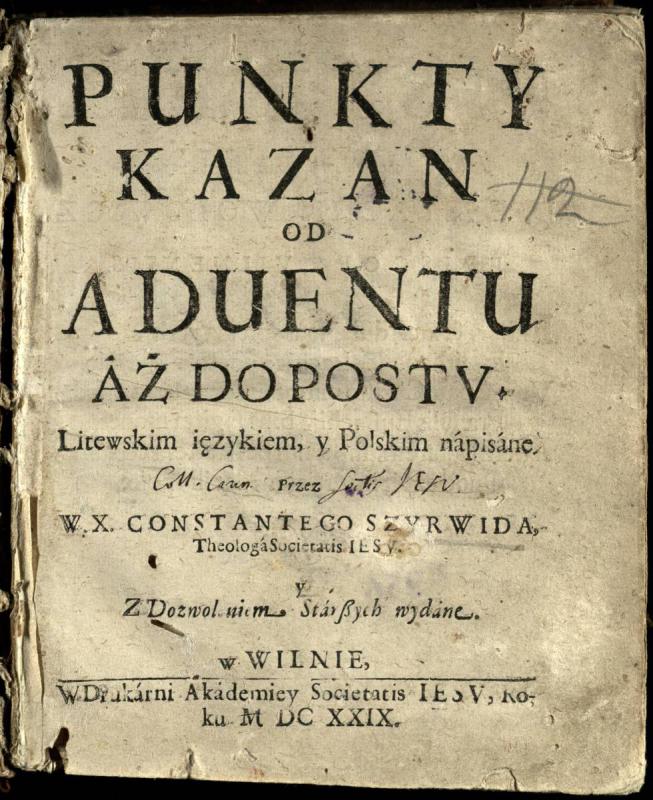
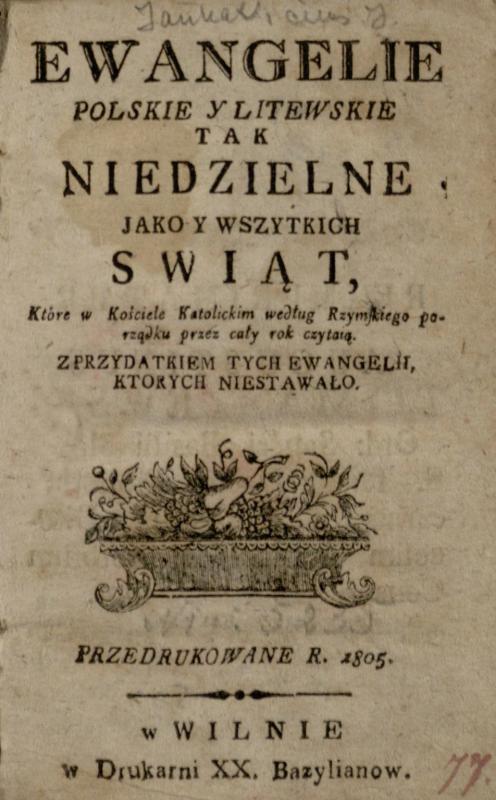
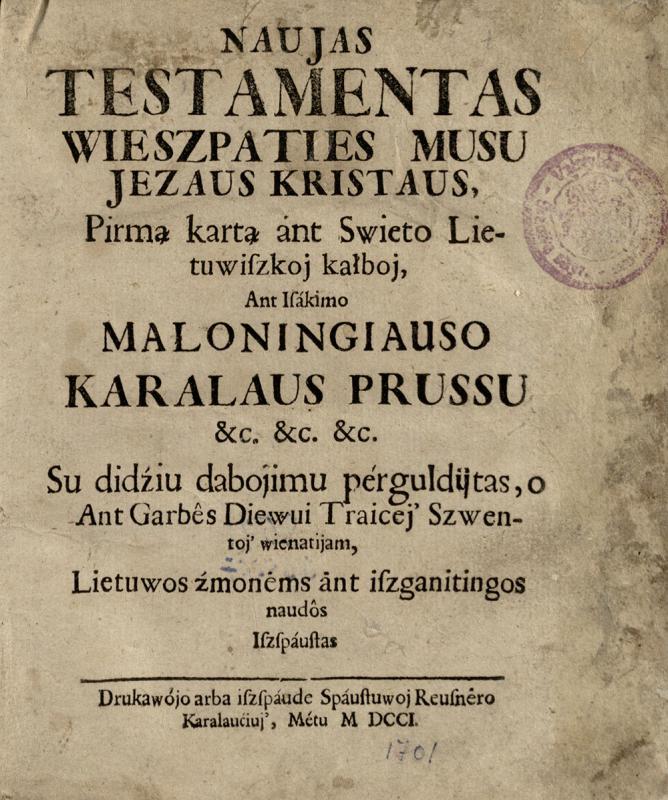

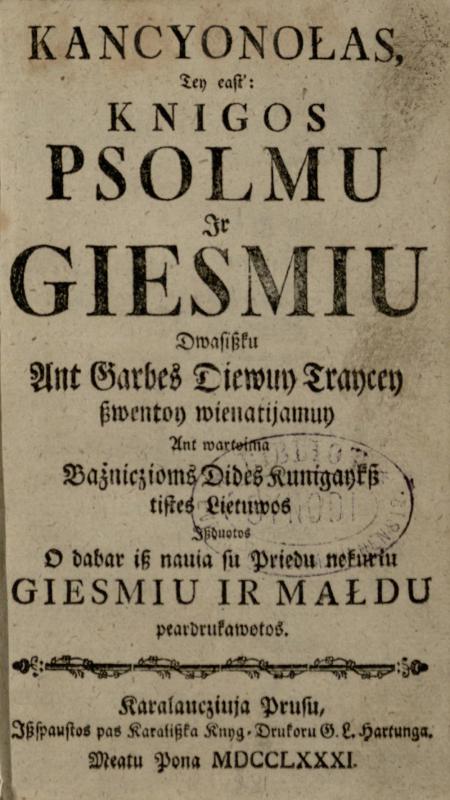
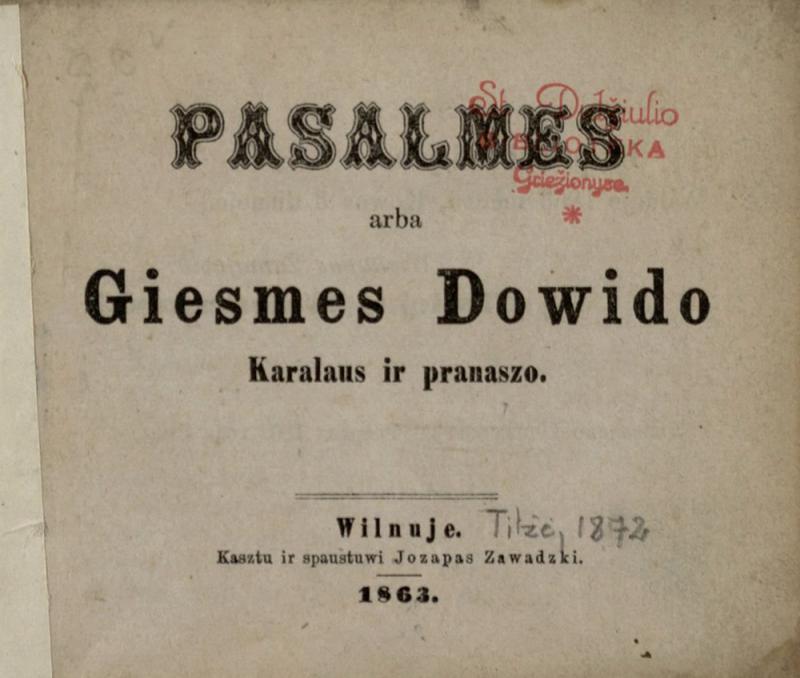
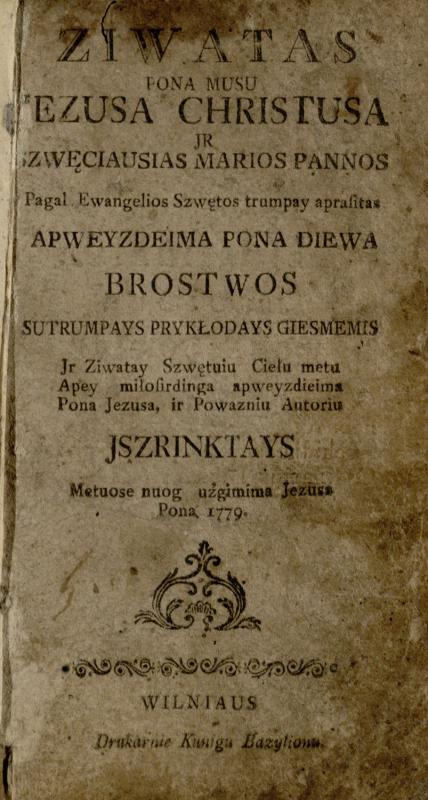
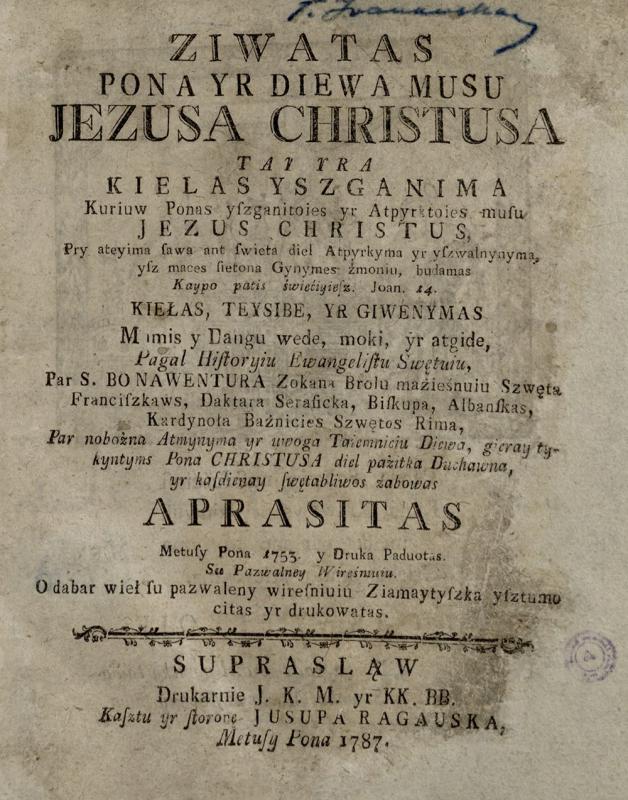
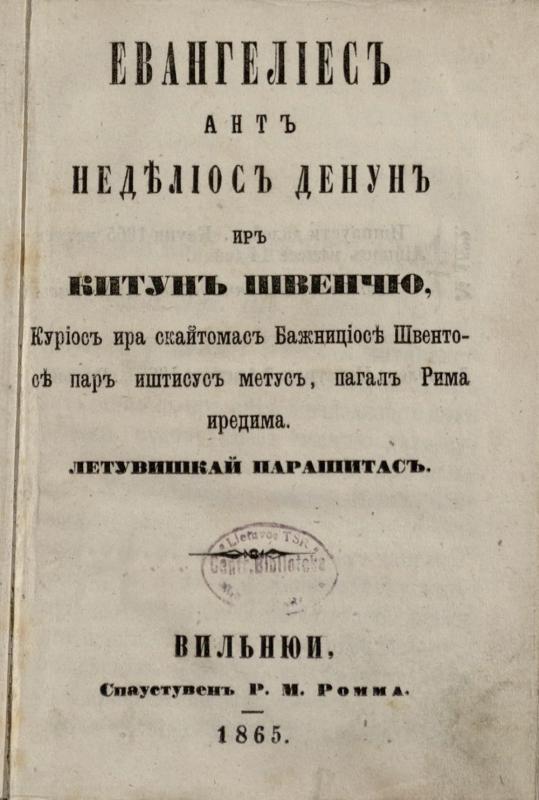
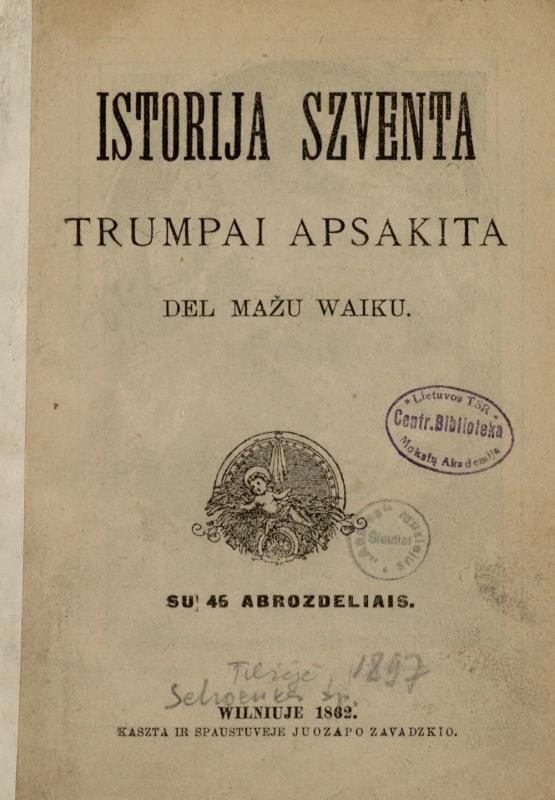
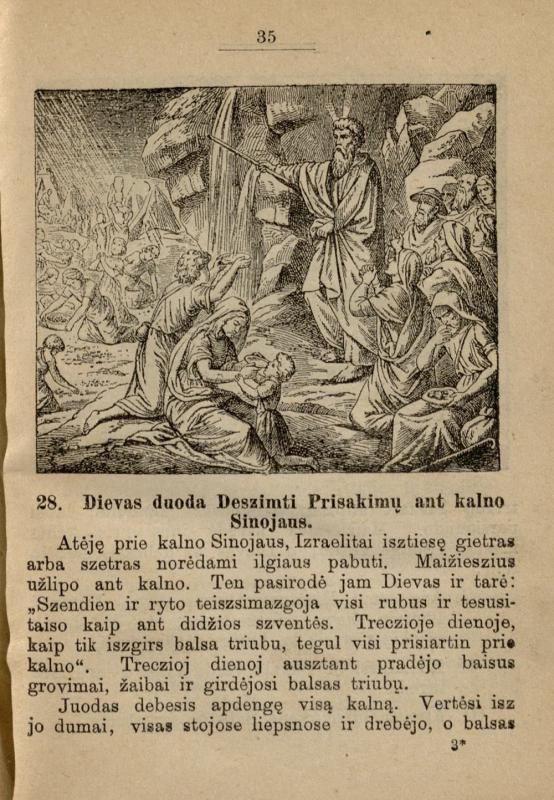
![Ewangelia Nikodemo, arba Trumpas nusidawimas apie gywasti Jezaus Kristaus, kuri Nikodemas, rabbins bey mokitojis źydû paźénklino, kaip jis pats tą buwo mátęs bey isztyręs kadangi jis pats paslieptas pasekejas ir mokįtinis Jezaus buwo. Prieg tam randasi daug grazu pasakejimu bey nusidawimu, kuriû ewangelistai neatsiminę. Podraug su nusidawimais apie toki rabbinna arba źydû mokįtoji, kursai régimay paźino, Kristu Diewo sunumi esanti isz Pilippo Kegelio pridejimo ant Dwásiszko wádo į dangiszką tewiszke imta. O galausey apie baises korawonês 12 źydiszkû giminû. Tilsit: Druck und Verlag von H. Post, [tarp 1862 ir 1870 m.]. Ewangelia Nikodemo, arba Trumpas nusidawimas apie gywasti Jezaus Kristaus, kuri Nikodemas, rabbins bey mokitojis źydû paźénklino, kaip jis pats tą buwo mátęs bey isztyręs kadangi jis pats paslieptas pasekejas ir mokįtinis Jezaus buwo. Prieg tam randasi daug grazu pasakejimu bey nusidawimu, kuriû ewangelistai neatsiminę. Podraug su nusidawimais apie toki rabbinna arba źydû mokįtoji, kursai régimay paźino, Kristu Diewo sunumi esanti isz Pilippo Kegelio pridejimo ant Dwásiszko wádo į dangiszką tewiszke imta. O galausey apie baises korawonês 12 źydiszkû giminû. Tilsit: Druck und Verlag von H. Post, [tarp 1862 ir 1870 m.].](http://web6.mab.lt/files/large/b48fe678ba6295edf58fdd340d0e0d2821951c73.jpg)
